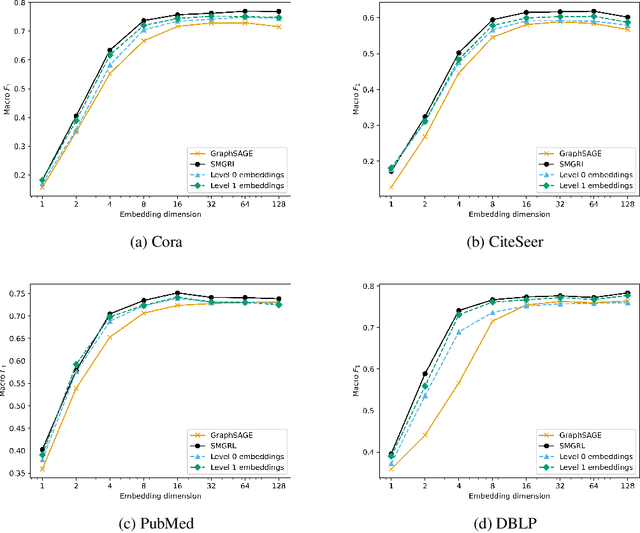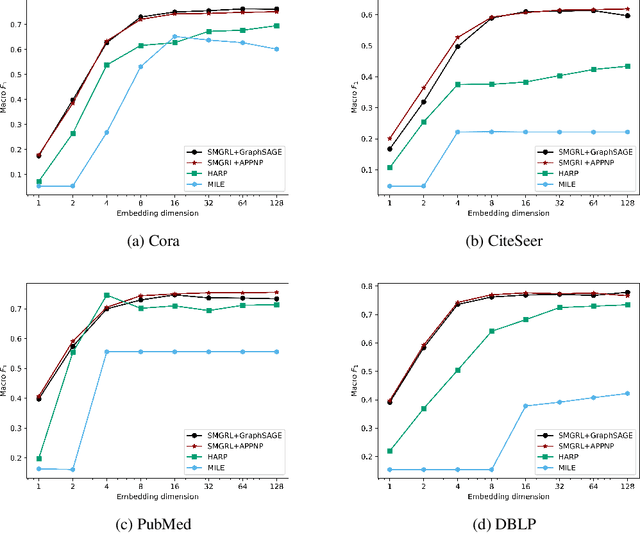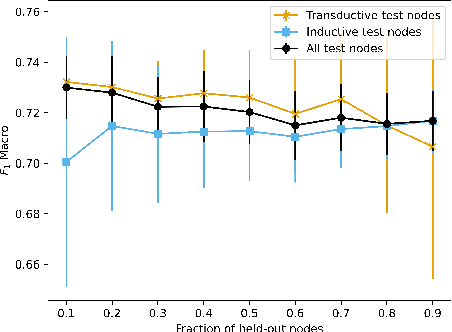Elahe Ghalebi
SMGRL: A Scalable Multi-resolution Graph Representation Learning Framework
Jan 29, 2022



Abstract:Graph convolutional networks (GCNs) allow us to learn topologically-aware node embeddings, which can be useful for classification or link prediction. However, by construction, they lack positional awareness and are unable to capture long-range dependencies without adding additional layers -- which in turn leads to over-smoothing and increased time and space complexity. Further, the complex dependencies between nodes make mini-batching challenging, limiting their applicability to large graphs. This paper proposes a Scalable Multi-resolution Graph Representation Learning (SMGRL) framework that enables us to learn multi-resolution node embeddings efficiently. Our framework is model-agnostic and can be applied to any existing GCN model. We dramatically reduce training costs by training only on a reduced-dimension coarsening of the original graph, then exploit self-similarity to apply the resulting algorithm at multiple resolutions. Inference of these multi-resolution embeddings can be distributed across multiple machines to reduce computational and memory requirements further. The resulting multi-resolution embeddings can be aggregated to yield high-quality node embeddings that capture both long- and short-range dependencies between nodes. Our experiments show that this leads to improved classification accuracy, without incurring high computational costs.
On Evaluation Metrics for Graph Generative Models
Jan 24, 2022



Abstract:In image generation, generative models can be evaluated naturally by visually inspecting model outputs. However, this is not always the case for graph generative models (GGMs), making their evaluation challenging. Currently, the standard process for evaluating GGMs suffers from three critical limitations: i) it does not produce a single score which makes model selection challenging, ii) in many cases it fails to consider underlying edge and node features, and iii) it is prohibitively slow to perform. In this work, we mitigate these issues by searching for scalar, domain-agnostic, and scalable metrics for evaluating and ranking GGMs. To this end, we study existing GGM metrics and neural-network-based metrics emerging from generative models of images that use embeddings extracted from a task-specific network. Motivated by the power of certain Graph Neural Networks (GNNs) to extract meaningful graph representations without any training, we introduce several metrics based on the features extracted by an untrained random GNN. We design experiments to thoroughly test metrics on their ability to measure the diversity and fidelity of generated graphs, as well as their sample and computational efficiency. Depending on the quantity of samples, we recommend one of two random-GNN-based metrics that we show to be more expressive than pre-existing metrics. While we focus on applying these metrics to GGM evaluation, in practice this enables the ability to easily compute the dissimilarity between any two sets of graphs regardless of domain. Our code is released at: https://github.com/uoguelph-mlrg/GGM-metrics.
Building LEGO Using Deep Generative Models of Graphs
Dec 21, 2020



Abstract:Generative models are now used to create a variety of high-quality digital artifacts. Yet their use in designing physical objects has received far less attention. In this paper, we advocate for the construction toy, LEGO, as a platform for developing generative models of sequential assembly. We develop a generative model based on graph-structured neural networks that can learn from human-built structures and produce visually compelling designs. Our code is released at: https://github.com/uoguelph-mlrg/GenerativeLEGO.
A Nonparametric Bayesian Model for Sparse Temporal Multigraphs
Oct 11, 2019Abstract:As the availability and importance of temporal interaction data--such as email communication--increases, it becomes increasingly important to understand the underlying structure that underpins these interactions. Often these interactions form a multigraph, where we might have multiple interactions between two entities. Such multigraphs tend to be sparse yet structured, and their distribution often evolves over time. Existing statistical models with interpretable parameters can capture some, but not all, of these properties. We propose a dynamic nonparametric model for interaction multigraphs that combines the sparsity of edge-exchangeable multigraphs with dynamic clustering patterns that tend to reinforce recent behavioral patterns. We show that our method yields improved held-out likelihood over stationary variants, and impressive predictive performance against a range of state-of-the-art dynamic graph models.
Dynamic Nonparametric Edge-Clustering Model for Time-Evolving Sparse Networks
May 29, 2019


Abstract:Interaction graphs, such as those recording emails between individuals or transactions between institutions, tend to be sparse yet structured, and often grow in an unbounded manner. Such behavior can be well-captured by structured, nonparametric edge-exchangeable graphs. However, such exchangeable models necessarily ignore temporal dynamics in the network. We propose a dynamic nonparametric model for interaction graphs that combine the sparsity of the exchangeable models with dynamic clustering patterns that tend to reinforce recent behavioral patterns. We show that our method yields improved held-out likelihood over stationary variants, and impressive predictive performance against a range of state-of-the-art dynamic interaction graph models.
Dynamic Network Model from Partial Observations
Jun 18, 2018


Abstract:Can evolving networks be inferred and modeled without directly observing their nodes and edges? In many applications, the edges of a dynamic network might not be observed, but one can observe the dynamics of stochastic cascading processes (e.g., information diffusion, virus propagation) occurring over the unobserved network. While there have been efforts to infer networks based on such data, providing a generative probabilistic model that is able to identify the underlying time-varying network remains an open question. Here we consider the problem of inferring generative dynamic network models based on network cascade diffusion data. We propose a novel framework for providing a non-parametric dynamic network model--based on a mixture of coupled hierarchical Dirichlet processes-- based on data capturing cascade node infection times. Our approach allows us to infer the evolving community structure in networks and to obtain an explicit predictive distribution over the edges of the underlying network--including those that were not involved in transmission of any cascade, or are likely to appear in the future. We show the effectiveness of our approach using extensive experiments on synthetic as well as real-world networks.
 Add to Chrome
Add to Chrome Add to Firefox
Add to Firefox Add to Edge
Add to Edge